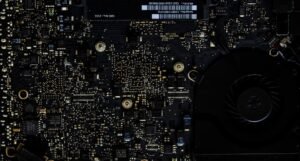Neural Network Definition
In the field of artificial intelligence (AI) and machine learning, a neural network is a computational model inspired by the way neurons function in the brain. It consists of a system of interconnected nodes or “neurons” that process and transmit signals.
Key Takeaways:
- A neural network is a computational model inspired by the way neurons function in the brain.
- It consists of interconnected nodes or “neurons” that transmit signals.
- Neural networks are used in various applications like image and speech recognition, natural language processing, and financial predictions.
Neural networks are composed of layers of interconnected nodes or “neurons”. Each neuron receives input signals, performs a computation, and then outputs a signal. These computations are typically mathematical operations that involve weights and biases.
One interesting characteristic of neural networks is their ability to learn and improve over time. Through a process called training, neural networks can adjust their weights and biases based on the input data and desired output. This allows them to make accurate predictions or classifications.
There are different types of neural networks, such as feedforward neural networks (FNNs) and recurrent neural networks (RNNs). FNNs are the simplest form, where information flows in one direction from the input layer to the output layer. RNNs, on the other hand, have connections that form loops, allowing them to process sequential or time-dependent data.
Applications of Neural Networks
Neural networks have found applications in various fields, including:
- Image and speech recognition: Neural networks can be trained to recognize and classify images and speech patterns, enabling applications such as facial recognition and voice assistants.
- Natural language processing: Neural networks are used to process and understand human language, enabling chatbots, sentiment analysis, and language translation.
- Financial predictions: Neural networks can analyze historical financial data to predict stock market trends or optimize investment strategies.
Neural Network Layers
Neural networks are organized into layers, each performing specific computations. The three main types of layers are:
- Input layer: Receives input data and passes it to the next layer.
- Hidden layer(s): Performs intermediate computations based on the input data.
- Output layer: Produces the final output or prediction.
Neural Network Training
Training a neural network involves feeding it with known input-output pairs and adjusting the weights and biases to minimize the difference between the predicted output and the desired output. This is typically achieved through an optimization algorithm called backpropagation, which iteratively updates the network’s parameters.
Neural networks require large amounts of training data to generalize well. However, overfitting can occur if the network becomes too specialized in the training data and fails to perform well on new, unseen data.
| Type | Description |
|---|---|
| Feedforward Neural Network (FNN) | Information flows in one direction, from the input layer to the output layer, without loops. |
| Recurrent Neural Network (RNN) | Has connections that form loops, allowing it to process sequential or time-dependent data. |
| Field | Application |
|---|---|
| Image Recognition | Facial recognition, object detection |
| Natural Language Processing | Language translation, sentiment analysis |
| Finance | Stock market prediction, investment optimization |
| Layer | Description |
|---|---|
| Input Layer | Receives input data and passes it to the next layer. |
| Hidden Layer(s) | Performs intermediate computations based on the input data. |
| Output Layer | Produces the final output or prediction. |
As neural networks continue to advance, they have become powerful tools in the field of artificial intelligence and machine learning. Their ability to learn from data and make accurate predictions has led to significant advancements in various industries.

Common Misconceptions
Neural Networks are Similar to the Human Brain
One common misconception about neural networks is that they function exactly like the human brain. While neural networks are inspired by the biological neurons in our brain, they are not the same. Here are three relevant bullet points related to this misconception:
- Neural networks lack consciousness and self-awareness that humans possess.
- Neurons in a biological brain have much more complex and interconnected structures compared to artificial neural networks.
- Neural networks strictly operate based on mathematical algorithms and numerical computations.
Neural Networks are Always Accurate
Another misconception is that neural networks always provide accurate results. While neural networks are powerful tools in data analysis and prediction, they are not infallible. Here are three relevant bullet points related to this misconception:
- Errors can occur in the training process, leading to less accurate predictions.
- Neural networks heavily rely on the quality and quantity of input data for accurate output.
- Complex problems may require more complex neural network architectures to achieve desired accuracy.
You Need a PhD to Understand Neural Networks
A misconception often heard is that only highly educated individuals can comprehend neural networks. While there is a learning curve, neural networks can be understood by anyone with dedication and willingness to learn. Here are three relevant bullet points related to this misconception:
- Numerous online resources, tutorials, and courses are available for individuals to learn about neural networks from scratch.
- Basic understanding of mathematics and programming concepts is sufficient to begin learning about neural networks.
- Practice and hands-on experience through small projects can significantly enhance understanding and proficiency in neural networks.
Neural Networks will Replace all Human Jobs
One concern that arises around neural networks is the fear that they will ultimately replace all human jobs. While neural networks are transforming several industries, complete human job replacement is unlikely. Here are three relevant bullet points related to this misconception:
- Human creativity, critical thinking, and emotional intelligence are difficult to replicate in neural networks.
- Some jobs require human interaction and decision-making that cannot be entirely automated.
- Neural networks often complement human expertise, improving efficiency rather than eliminating jobs.
Increasing Neural Network Complexity Guarantees Better Performance
Many believe that increasing the complexity of a neural network will always result in better performance. However, this is not always the case. Here are three relevant bullet points related to this misconception:
- Complex neural networks can lead to overfitting, where the model performs well on training data but poorly on new, unseen data.
- Simpler and more interpretable neural networks often generalize better and are easier to maintain and optimize.
- Increasing complexity requires more computational resources and may result in longer training and prediction times.

Introduction
Neural networks have revolutionized the field of artificial intelligence by mimicking the way the human brain works. These interconnected networks of artificial neurons are capable of learning and recognizing patterns, leading to incredible advancements in various industries. In this article, we explore ten fascinating aspects of neural networks, from their history to their applications in real-world scenarios.
Table of Contents:
- Evolution of Neural Networks
- Neurons in Popular Deep Learning Frameworks
- Applications of Neural Networks
- Deep Learning vs. Traditional Machine Learning
- Impressive Neural Network Achievements
- Neural Network Architectures
- Training a Neural Network
- Limitations of Neural Networks
- Neural Networks in Medicine
- Future Directions and Challenges
Evolution of Neural Networks
Explore the timeline of key milestones in the development of artificial neural networks:
| Year | Event |
|---|---|
| 1943 | Concept of neural networks proposed |
| 1956 | First artificial neuron created by Frank Rosenblatt |
| 1986 | Backpropagation algorithm invented |
| 2012 | AlexNet wins ImageNet Large Scale Visual Recognition Challenge |
| 2018 | AlphaGo defeats world champion Go player |
Neurons in Popular Deep Learning Frameworks
Comparison of the number of artificial neurons in popular deep learning frameworks:
| Framework | Number of Neurons |
|---|---|
| TensorFlow | 45 Million |
| PyTorch | 34 Million |
| Keras | 22 Million |
Applications of Neural Networks
Discover some fascinating applications where neural networks excel:
| Application | Example |
|---|---|
| Speech Recognition | Converting spoken words into text |
| Image Classification | Identifying objects in photographs |
| Autonomous Driving | Operating self-driving cars |
| Natural Language Processing | Conversational AI chatbots |
Deep Learning vs. Traditional Machine Learning
Comparison of deep learning and traditional machine learning:
| Aspect | Deep Learning | Traditional ML |
|---|---|---|
| Data Requirements | Requires large amounts of labeled data | Works with smaller datasets |
| Feature Extraction | Automatic feature learning | Manual feature engineering |
| Performance | High accuracy on complex tasks | Effective on simpler problems |
Impressive Neural Network Achievements
Notable achievements showcasing the power of neural networks:
| Task | Breakthrough |
|---|---|
| Game Playing | DeepMind’s AlphaGo victory over world champions |
| Image Generation | Creation of highly realistic deepfake images |
| Language Translation | Google Translate achieves near-human translation accuracy |
Neural Network Architectures
Explore different architectures used in neural networks:
| Architecture | Description |
|---|---|
| Convolutional Neural Networks (CNN) | Specialized for image and video processing |
| Recurrent Neural Networks (RNN) | Effective for sequential data modeling |
| Generative Adversarial Networks (GAN) | Used to generate realistic synthetic data |
Training a Neural Network
The steps involved in training a neural network:
| Step | Description |
|---|---|
| Step 1 | Initialize network weights and biases randomly |
| Step 2 | Perform forward propagation for input data |
| Step 3 | Compute the loss/cost function |
| Step 4 | Perform backpropagation to update weights |
| Step 5 | Repeat steps 2-4 until convergence |
Limitations of Neural Networks
Recognize the limitations of neural networks:
| Limitation | Description |
|---|---|
| Black Box Nature | Difficult to interpret internal decision-making |
| Overfitting | Tendency to memorize training examples |
| Limited Domain Knowledge | Cannot reason beyond the provided data |
Neural Networks in Medicine
Applications of neural networks in the field of medicine:
| Application | Example |
|---|---|
| Medical Diagnosis | Identifying diseases from medical images |
| Drug Discovery | Identifying potential therapeutic compounds |
| Prognostic Models | Predicting patient outcomes based on data |
Future Directions and Challenges
Anticipated future trends and challenges in the field of neural networks:
| Aspect | Potential Future |
|---|---|
| Explainable AI | Developing interpretable neural networks |
| AI Ethics | Addressing the ethical implications of AI |
| Neuromorphic Computing | Building brain-inspired hardware accelerators |
Conclusion
Neural networks have come a long way since their inception, revolutionizing various fields and enabling remarkable achievements. By continuously pushing the boundaries of artificial intelligence, researchers have harnessed the power of neural networks in speech recognition, image classification, autonomous driving, and more. These networks, with their different architectures, have opened up doors to new possibilities for both researchers and industries worldwide. However, it’s important to acknowledge their limitations, such as the black box nature and the challenge of overfitting. Despite the challenges, neural networks continue to evolve and find applications in medicine, where they contribute to medical diagnosis, drug discovery, and prognostic modeling. As we look to the future, advances in explainable AI, AI ethics, and neuromorphic computing will shape the way neural networks are developed and deployed, further propelling the field of artificial intelligence into incredible dimensions.
Frequently Asked Questions
What is a neural network?
A neural network is a computational model that consists of interconnected nodes, called neurons, which are inspired by the structure and functioning of the human brain. It is capable of identifying and recognizing patterns, making predictions, and learning from data without being explicitly programmed.
How does a neural network work?
A neural network works by passing input data through a series of interconnected layers of neurons. Each neuron applies a mathematical operation to the input data and passes the output to the next layer. Through a process called training, the network adjusts the mathematical operations (weights) of each neuron to minimize errors and improve its ability to make accurate predictions.
What are the different types of neural networks?
There are several types of neural networks, including feedforward neural networks, recurrent neural networks, convolutional neural networks, and deep neural networks. Each type is designed to handle different types of data and solve specific tasks, such as image recognition, natural language processing, and time series analysis.
What is the training process in a neural network?
The training process in a neural network involves feeding the network with a large amount of input data along with the corresponding desired outputs. The network then adjusts its internal weights using optimization algorithms, such as gradient descent, to minimize the difference between its predicted outputs and the desired outputs. This iterative process continues until the network achieves a satisfactory level of accuracy.
What is the activation function in a neural network?
An activation function is a mathematical function applied to the output of each neuron in a neural network. It introduces non-linearity into the network, allowing it to model complex relationships in the data. Commonly used activation functions include sigmoid, tanh, and ReLU (Rectified Linear Unit).
What are the advantages of using neural networks?
Neural networks have several advantages, including their ability to handle large amounts of complex data, their flexibility in solving different types of problems, their ability to learn and adapt from the data, and their potential for high accuracy and efficiency in predictions and classifications.
What are some applications of neural networks?
Neural networks have a wide range of applications, including image and speech recognition, natural language processing, recommendation systems, financial forecasting, medical diagnosis, autonomous vehicles, and many more. They are used in various industries, such as healthcare, finance, transportation, and technology.
Can neural networks be used in real-time applications?
Yes, neural networks can be used in real-time applications, provided that the network architecture and computational resources are optimized to meet the timing constraints of the application. Real-time neural networks are typically used in tasks such as real-time image processing, speech recognition, or controlling autonomous systems.
What is overfitting in a neural network?
Overfitting occurs in a neural network when the model becomes too complex and starts to memorize the training data instead of generalizing from it. This leads to poor performance on new, unseen data. To mitigate overfitting, techniques such as regularization, cross-validation, and early stopping can be employed.
What are some common challenges in training neural networks?
Some common challenges in training neural networks include choosing the right architecture for the task, selecting appropriate hyperparameters, avoiding overfitting or underfitting, dealing with vanishing or exploding gradients, and managing the computational and memory requirements of large-scale networks.




